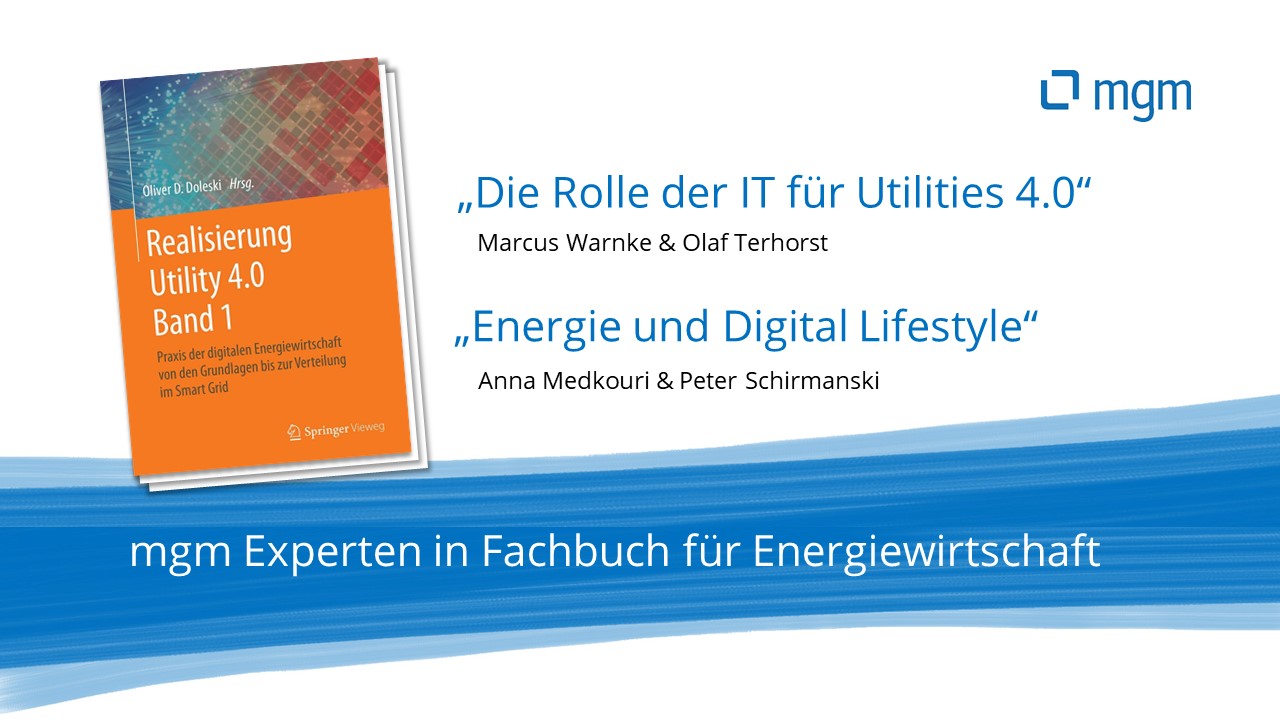
More from author Marcus Warnke in “Realisierung Utility 4.0”
Like many other industries, the energy industry is in the midst of a digital transformation. The two-volume specialist publication “Realization Utility 4.0”, which has been published by Springer-Verlag, sheds light on how this transformation can be successfully managed.
Olaf Terhorst and Marcus Warnke dedicate their chapter to the role of IT for Utilities 4.0.
Structural changes in the energy supply market require rethinking
Prosumer – this artificial word made up of “producer” and “consumer” stands like no other for the changes that the electricity industry is currently undergoing. The customer, or better: the contractual partner, is no longer just a buyer of electricity or gas. With photovoltaics, block-type thermal power stations and domestic storage, many have also become suppliers. Or in another picture: The entire system of power generation and consumption has grown from a one-way street to a road network with countless intersections.
At the same time, customer expectations are changing. Customers today have completely different ideas and needs: Simple and fast interaction, accessibility in the broadest sense and individual solutions are the focus.
Analysts assume that competitors from outside the industry could enter the market.
This development is driven by suppliers from other industries. Amazon and Co. are much more advanced in terms of service and customer centricity than the large energy suppliers. Analysts assume that competitors from outside the industry could enter the market. And why not? The entry threshold is conceivably low: A supplier does not have to be a producer or network operator – the electricity market has been liberalized, and almost all processes can be purchased externally as a service. The most important sales argument is the positive – mostly digital – customer experience, so one of the most important branches of business is therefore IT.
Commodity and product differentiation – a contradiction?
Even at the beginning of the 21st century, electricity (or gas) was above all one thing: a means to an end, a commodity – an object of daily use. The essential contact between companies and their customers was the annual billing – not necessarily the most popular item in the mailbox.
What is the situation today? Electricity continues to be an indispensable basis of modern life. In this respect, the providers have remained commodities. The annual statement of accounts offers hardly any opportunities for differentiation, especially since the pricing through comparison portals is extremely transparent and all suppliers strive to keep this process as simple as possible. In practice, this is certainly an aspect that companies are still working on.
The solution leads away from “electricity as a universal commodity” to customer-centric services.
But how can product differentiation be implemented in the energy sector? The solution leads away from “electricity as a universal commodity” to customer-centric services. It is about selling customers what they need electricity for: Mobility, heat, entertainment … and more: services and benefits that revolve around energy – especially for prosumers. Apps or IoT applications are concrete examples.
Data as the basis for new business models
For a long time, coal was the most important raw material for producers. In the future electricity will be generated predominantly from renewable sources. But for the utilities it is no longer a question of generation. The driving force behind business success is data. They may not supply electricity, but they do supply something that has long since become indispensable for suppliers: Information about customers, their preferences and options. They are the basis for developing new products. Experts agree on this. And there is another point on which they agree: that the data is not yet being used exhaustively.
One challenge for energy suppliers is that the routes and use of electricity often remain unknown. What happens up to and behind the electricity meter? Many companies are only now beginning to determine this.
One challenge for energy suppliers is that the routes and use of electricity often remain unknown.
The findings are then used not only to improve the offerings and usability – they also form the basis for optimizing the operational technology. The principle behind this is by no means new: There is probably no industrial company that does without the core data of production in order to control and improve it. Similarly, energy providers are faced with the question of how electricity flows commercially and physically.
Only those who can trace the paths and use of the electricity are in a position to control the network and its services intelligently. This knowledge brings the supplier closer to the customer and his needs. In the environment of energy suppliers, however, data is not only a goldmine but also a challenge: Separating the market roles of network and sales partly prevents data transparency – and secure data protection is essential.
Customer focus as the key to success
This again shows the parallels to Amazon, Apple and Co. These providers have understood how to present individual solutions to their customers. They have put customer centricity first – and at the same time invested in secure cloud solutions. The first start-ups in the energy sector are now appearing on the scene with a similar approach. They offer their customers more than just electricity or gas: The digital lifestyle has arrived in the energy industry. Usability does not necessarily have to meet Apple standards, but rather be simple and variable for all user groups and end devices. Nevertheless, established utilities are required to follow suit with apps and customer-oriented, digitalized processes and offers.
In summary, it is clear that energy suppliers must bundle various competencies in order to be successful in the future.
In summary, it is clear that energy suppliers must bundle various competencies in order to be successful in the future. IT plays a decisive role in this. It is faced with the task of combining data protection, operational technology and usability into a resilient concept. And, together with the business, to create consistent customer focus.
More from author Marcus Warnke in “Realisierung Utility 4.0”
Like many other industries, the energy industry is in the midst of a digital transformation. The two-volume specialist publication “Realization Utility 4.0“, which has been published by Springer-Verlag, sheds light on how this transformation can be successfully managed.
Olaf Terhorst and Marcus Warnke devote their chapter to the role of IT for Utilities 4.0. In their experience, IT is currently becoming a determining factor, independent of the business model. Where IT used to act as a service provider for the specialist departments or the business, it is now becoming the central hub. IT is business and business is IT.









